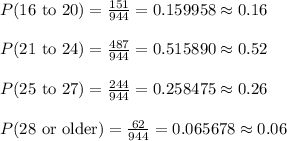
Mathematics, 15.10.2020 08:01 wyattmiller
Junior Achievement USA and the Allstate Foundation surveyed teenagers aged 14 to 18 and asked at what age they think they will become financially independent. The responses of 944 teenagers who answered this survey question as follows:
Age Financially Independent Number of Responses
16 to 20 151
21 to 24 487
25 to 27 244
28 or older 62
Consider the experiment of randomly selecting a teenager from the population of teenagers aged to 14 to 18.
Required:
a. Compute the probability of being financially independent for each of the four age categories.
b. What is the probability of being financially independent before the age of 25?
c. What is the probability of being financially independent after the age of 24?

Answers: 3
Another question on Mathematics


Mathematics, 21.06.2019 19:30
The revenue each season from tickets at the theme park is represented by t(c)=5x. the cost to pay the employees each season is represented by r(x)=(1.5)^x. examine the graph of the combined function for total profit and estimate the profit after four seasons
Answers: 3

Mathematics, 21.06.2019 19:30
Michelle and julie work at a catering company. they need to bake 264 cookies for a birthday party that starts in a little over an hour and a half. each tube of cookie dough claims to make 36 cookies, but michelle eats about 1/5 of every tube and julie makes cookies that are 1.5 times as large as the recommended cookie size.it takes about 8 minutes to bake a container of cookies, but since julie's cookies are larger, they take 12 minutes to bake. a. how many tubes should each girl plan to bake? how long does each girl use the oven? b. explain your solution process what did you make? c. what assumptions did you make?
Answers: 1

Mathematics, 21.06.2019 21:30
In a test for esp (extrasensory perception), the experimenter looks at cards that are hidden from the subject. each card contains either a star, a circle, a wave, a cross or a square.(five shapes) as the experimenter looks at each of 20 cards in turn, the subject names the shape on the card. when the esp study described above discovers a subject whose performance appears to be better than guessing, the study continues at greater length. the experimenter looks at many cards bearing one of five shapes (star, square, circle, wave, and cross) in an order determined by random numbers. the subject cannot see the experimenter as he looks at each card in turn, in order to avoid any possible nonverbal clues. the answers of a subject who does not have esp should be independent observations, each with probability 1/5 of success. we record 1000 attempts. which of the following assumptions must be met in order to solve this problem? it's reasonable to assume normality 0.8(1000), 0.2(1000)%30 approximately normal 0.8(1000), 0.2(1000)% 10 approximately normal srs it is reasonable to assume the total number of cards is over 10,000 it is reasonable to assume the total number of cards is over 1000
Answers: 1
You know the right answer?
Junior Achievement USA and the Allstate Foundation surveyed teenagers aged 14 to 18 and asked at wha...
Questions



Mathematics, 19.05.2021 21:50

Mathematics, 19.05.2021 21:50


History, 19.05.2021 21:50



Biology, 19.05.2021 21:50

Mathematics, 19.05.2021 21:50

English, 19.05.2021 21:50

Mathematics, 19.05.2021 21:50

Chemistry, 19.05.2021 21:50

Mathematics, 19.05.2021 21:50

Mathematics, 19.05.2021 21:50

Mathematics, 19.05.2021 21:50







